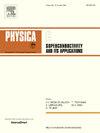Critical current density properties of thick YBa2Cu3Oy films with different thicknesses
IF 1
3区 物理与天体物理
Q4 PHYSICS, APPLIED
Physica C-superconductivity and Its Applications
Pub Date : 2025-05-12
DOI:10.1016/j.physc.2025.1354734
引用次数: 0
Abstract
Even in REBa2Cu3Oy (REBCO) films, which exhibit high critical current density (Jc) under low-temperature and high-magnetic-field conditions, their performance deteriorates significantly at high-temperatures because of pronounced flux creep induced by thermal agitation. This degradation is particularly pronounced in thin superconducting films, as the thickness constrains the pinning correlation length. In this study, we examined the effect of YBCO film thickness on Jc within the range of 0.94 to 3.7 μm. While some variations were observed depending on crystal orientation, thicker superconducting layers demonstrated a smaller reduction in Jc with increasing magnetic field in high-temperature regions, resulting in superior Jc values under high-temperature and high-magnetic-field conditions. Moreover, the apparent pinning potential , determined from magnetization relaxation measurements, was larger for thicker films in these conditions, indicating that is influenced by the thickness of the superconducting layer. These findings are further supported by the flux creep flow model analysis. Collectively, these results suggest that not only introducing strong pinning forces but also increasing the thickness of the superconducting layer is an effective strategy for enhancing performance near liquid nitrogen temperatures.
不同厚度YBa2Cu3Oy厚膜的临界电流密度特性
即使REBa2Cu3Oy (REBCO)薄膜在低温和高磁场条件下具有较高的临界电流密度(Jc),但由于热搅拌引起的明显的磁流变,其性能在高温下也会显著恶化。这种退化在超导体薄膜中尤其明显,因为厚度限制了钉钉相关长度。在本研究中,我们考察了YBCO薄膜厚度在0.94 ~ 3.7 μm范围内对Jc的影响。在高温区域,随着磁场的增加,更厚的超导层Jc的降低幅度更小,导致高温和高磁场条件下的Jc值更高。此外,在这些条件下,由磁化弛豫测量确定的表观钉住电位U0*在较厚的薄膜中较大,表明U0*受超导层厚度的影响。这些发现得到了通量蠕变流模型分析的进一步支持。综上所述,这些结果表明,不仅引入强大的钉住力,而且增加超导层的厚度是提高液氮温度附近性能的有效策略。
本文章由计算机程序翻译,如有差异,请以英文原文为准。
求助全文
约1分钟内获得全文
求助全文
来源期刊
CiteScore
2.70
自引率
11.80%
发文量
102
审稿时长
66 days
期刊介绍:
Physica C (Superconductivity and its Applications) publishes peer-reviewed papers on novel developments in the field of superconductivity. Topics include discovery of new superconducting materials and elucidation of their mechanisms, physics of vortex matter, enhancement of critical properties of superconductors, identification of novel properties and processing methods that improve their performance and promote new routes to applications of superconductivity.
The main goal of the journal is to publish:
1. Papers that substantially increase the understanding of the fundamental aspects and mechanisms of superconductivity and vortex matter through theoretical and experimental methods.
2. Papers that report on novel physical properties and processing of materials that substantially enhance their critical performance.
3. Papers that promote new or improved routes to applications of superconductivity and/or superconducting materials, and proof-of-concept novel proto-type superconducting devices.
The editors of the journal will select papers that are well written and based on thorough research that provide truly novel insights.

 求助内容:
求助内容: 应助结果提醒方式:
应助结果提醒方式:


